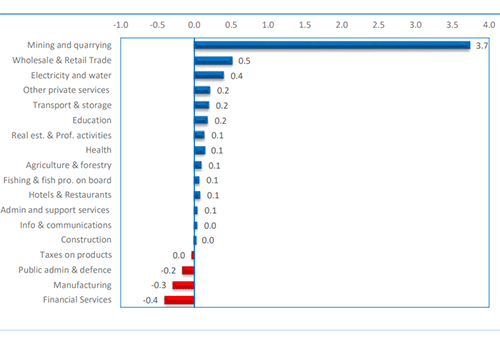During the first quarter of 2023, the economy grew by 5% compared to 7.3% recorded in the corresponding quarter of 2022. The slow performance is largely attributable to the contractions observed in the sectors of financial services activities, manufacturing activities, and public administration and defence.
Additionally, the agriculture and forestry and health sectors experienced notable slowdowns.
These was released last week by the Namibia Statistics Agency (NSA). The report added, the sectors of mining and quarrying, and electricity and water witnessed significant growth rates of 34.3%, and 16.8% compared to 28.5%, and 4.1% recorded in the corresponding quarter of 2022, respectively.
“Overall, economic activities also accelerated in the sectors of administrative and support services (7.3%), transport and storage (6.7%), wholesale and retail trade (5.7%), and hotels and restaurants (5.7%) compared to the growth rates of 2.2%, 2.3%, 2%, and 4.6% witnessed in the first quarter of 2022, respectively,” reads the
report.
Mining and quarrying continued as the main contributor to the gross domestic product (GDP) growth rate of 5%, contributing 3.7 percentage points followed by wholesale and retail and electricity and water with the contribution of 0.5 percentage points and 0.4 percentage points respectively.
Significant contribution
Mining and quarrying sector registered a growth of 34.3% in real value added during the first quarter of 2023, compared to an increase of 28.5% recorded in the corresponding quarter of 2022.
Alex Shimuafueni, CEO of NSA stated the improved performance in the sector is attributed to the subsector of other mining and quarrying which accelerated by 68.8% in real value added during the period under review.
“The performance in the subsector is attributed to increased investments for mineral exploration activities. Moreover, Uranium subsector during the current quarter recorded a double-digit growth of 35.9% in real value added relative to a decline of 11.6% observed in the corresponding quarter of the preceding year,” he stated.
The agency added the increased uranium production levels have played a pivotal role in driving the positive growth, contributing to the overall improvement in the sector’s performance.
Awakened giant
After six consecutive contractions, the construction sector registered a marginal increase of 0.9% in real value added during the period under review compared to a decline of 7.3% registered in the corresponding quarter of 2022.
“The performance in the sector is mainly reflected in the real value of government expenditure on construction that registered an increase of 13.2% during the period under review compared to a contraction of 16% in the corresponding quarter of 2022. This is mainly attributed to government expenditures on roads, railway and water infrastructure,” it added.
Concern
However, the average real value of buildings plans approved and completed registered a decline of 13.6% during the period under review compared to the huge decline of 24.7% in the corresponding quarter of 2022. The decline is reflected in the real value of residential buildings that improved during the period under review.
Building plans are described as an excellent economic barometer, as it creates direct jobs as well as income and tax revenue for the State, and significantly contributes to strong economic performance.
As such, the persistent declines are not a promising sign for the uptick of domestic economic activity after the impact of the Covid-19 pandemic.


